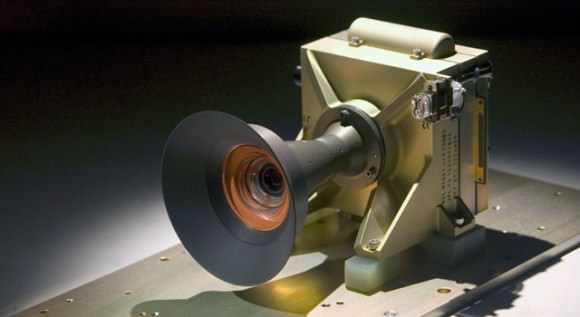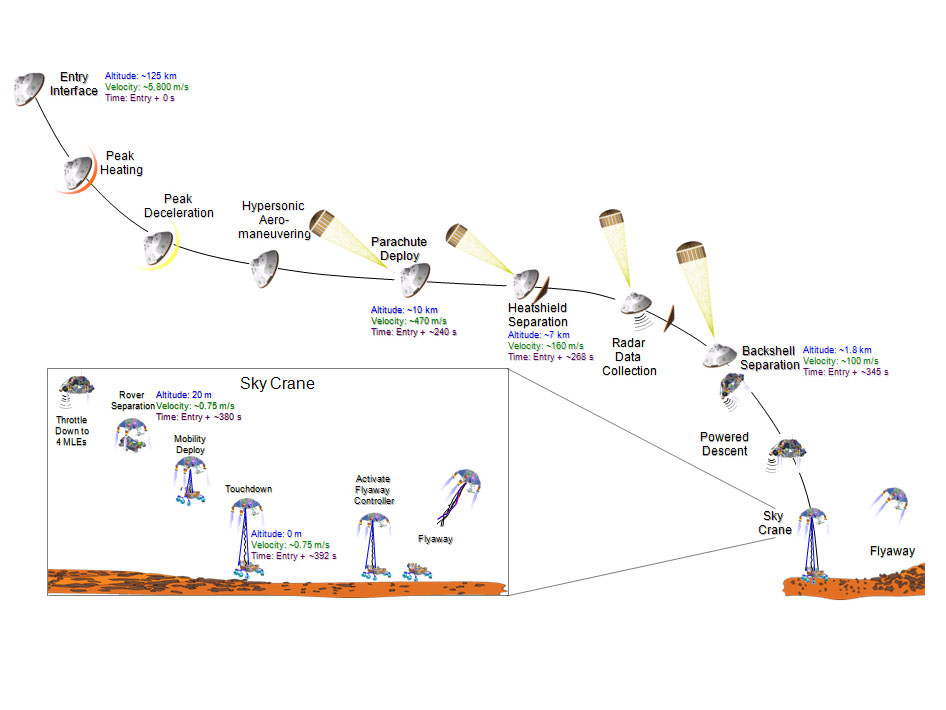[/caption]
Now THIS is what I call “must-see TV!” A camera on the next Mars Rover — MSL, also known as Curiosity – will start recording high-definition video about two minutes before the rover lands on Mars, currently scheduled for August 2012. The Mars Descent Imager, or MARDI, will provide all of us Martian-wannabes with the first-ever ride along with the landing — and this will be a very unique landing, with the “Sky –Crane” lowering Curiosity to the planet’s surface. The video won’t be live, however – that’s way too much data for the spacecraft to send back to Earth at such an important event, but we will get to see it later. JPL provided a description of what the video should look like:

MARDI will start recording high-resolution video about two minutes before landing in August 2012. Initial frames will glimpse the heat shield falling away from beneath the rover, revealing a swath of Martian terrain below illuminated in afternoon sunlight. The first scenes will cover ground several kilometers (a few miles) across. Successive images will close in and cover a smaller area each second.
The full-color video will likely spin, then shake, as the Mars Science Laboratory mission’s parachute, then its rocket-powered backpack, slow the rover’s descent. The left-front wheel will pop into view when Curiosity extends its mobility and landing gear.
The spacecraft’s own shadow, unnoticeable at first, will grow in size and slide westward across the ground. The shadow and rover will meet at a place that, in the final moments, becomes the only patch of ground visible, about the size of a bath towel and underneath the rover.
Dust kicked up by the rocket engines during landing may swirl as the video ends and Curiosity’s surface mission can begin.
All of this, recorded at about four frames per second and close to 1,600 by 1,200 pixels per frame, will be stored safely into the Mars Descent Imager’s own flash memory during the landing. But the camera’s principal investigator, Michael Malin of Malin Space Science Systems, San Diego, and everyone else will need to be patient. Curiosity will be about 250 million kilometers (about 150 million miles) from Earth at that point. It will send images and other data to Earth via relay by one or two Mars orbiters, so the daily data volume will be limited by the amount of time the orbiters are overhead each day.
“We will get it down in stages,” said Malin. “First we’ll have thumbnails of the descent images, with only a few frames at full scale.”
Subsequent downlinks will deliver additional frames, selected based on what the thumbnail versions show. The early images will begin to fulfill this instrument’s scientific functions. “I am really looking forward to seeing this movie. We have been preparing for it a long time,” Malin said. The lower-resolution version from thumbnail images will be comparable to a YouTube video in image quality. The high-definition version will not be available until the full set of images can be transmitted to Earth, which could take weeks, or even months, sharing priority with data from other instruments.”


I think MSL will be just incredible. Here’s hoping to no more additional delays.
Should have been MARs Descent Imager – GRound Approach System.
That will be fantastic, the Titan descent video was good and this will be better.
.
Yet another area where the mobile craze pays off (small & cheap cameras). The japanese solar sail even _threw away_ wireless cameras to look at deployment.
(Not that I think planetary probes necessarily should pollute their exploration area thusly…)
@ Navneeth:
Nice, you may compete with the dedicated guys over at Dumb Or Overly Forced Astronomical Acronyms Site (or DOOFAAS).
My favorite so far is “GADZOOKS! – Gadolinium Antineutrino Detector Zealously Outperforming Old Kamiokande, Super! (PI insists on the exclaimation [sic] point! Awesome!)”, albeit “ARISTOTELES – Applications and Research Involving Space Technologies Observing the Earth’s field from Low Earth orbiting Satellite” is a heavy competitor.
We can start a page solely for MARS exploration! (“MARS – Maybe Another Rover Soon”.)
An important point about this is if something goes wrong in landing we can find out what happened, of course that data has to get back to us also.
I’m really looking forward to this mission.
I suppose Sky Crain make sense. Use Science Labs wheel as a landing gear, and not carry redundant landing gear on descent stage. There is a weight saving and less complexity, so long as Sky Crain is not too complex.
4 fps isn’t really HD video, it’s closer to what a DSLR will give you if you shoot photos in quick succession. They won’t be able to make a HD landing video out of it (unless it’s really choppy). It sounds like the goal is HD *photos* of the landing, not video.
This will be a martian version of the videos of the moon landing. Should be interesting.
LC
If they build up their confidence, maybe they can go directly from the parachute stage to crane, no rockets. It might take more rope, but will be cleaner.
This will be really cool to see! I wonder just how long it will take to get all the high-def images back and assembled….anyone want to make a wager on which end of the “weeks, or months” spectrum it will be?
I really hate the skycrane idea. Too many things can go wrong. My biggest fear being the lander spinning as it decends, one of the cables doesn’t release fully… and the lander gets dragged off by the crane.
Downward thrust from the skycrane along with a Martian wind, and it will not take much for the lander to begin spinning. Even a slow spin could result in problems.
CEB, Aodhhan: It’s complex, surely, but it’s a promising tryout of a compromise for heavier loads.
I envision the next step would be one of those descent aerobodies that people (will) try out for the heaviest loads/manned landing.
But this platform is supposed to be the thing for this load range for the time being, or so I believed; it would cut down on development cost the next time around. Indeed, the ExoMars rover -18 will use the exact same sky-crane, I believe.
Really… I need to learn a bit more about how the skycrane works. Likely they have anticipated this problem (especially after watching the Cassini probe), and hopefully have an answer to it.
Considering the Martian atmosphere, and all the other limitations they have to deal with… it really appears to be a fantastic method of landing. I look forward to the video.
don’t get me wrong – the skycrane is a very elegant idea. gets you a lot control authority exactly when you need it w/o making you carry a ton of extra propellant weight.
I like it so much that I hope it might be possible to sky-crane directly from the parachute terminal glide…
The inflatables will reduce the weight of the high-temp heat shield, but I don’t think they’ll make the parachute descent any slower.
Here is a link to that Titan movie that SteveZodiac mentioned:
http://www.nasa.gov/mission_pages/cassini/multimedia/pia08117.html